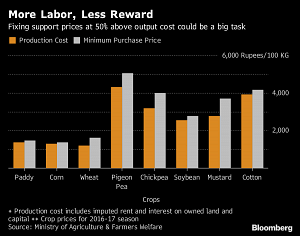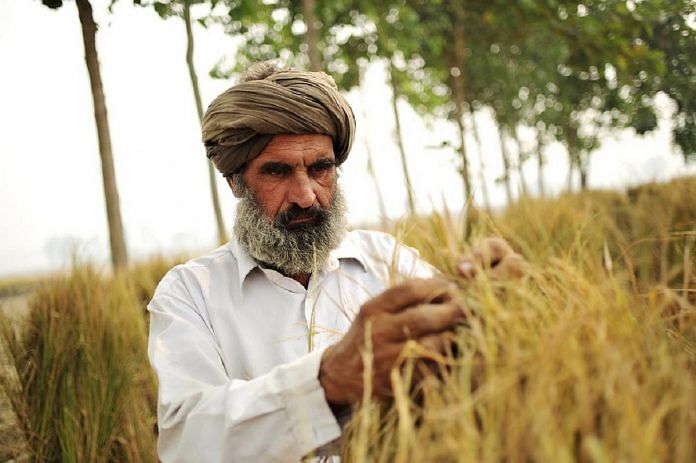Giving farmers a guaranteed price will not only help in stabilising the market and increasing output but also bolster support for Modi ahead of 2019 elections.
India’s Prime Minister Narendra Modi pledged to double farm incomes by 2022. The most cost-effective way of fulfilling that may be by compensating farmers with cash when market prices of crops fall below support rates, a government adviser said.
The plan is one among three suggestions being discussed by the National Institution for Transforming India, a government think-tank also known as NITI Aayog, which has been tasked to find ways to ensure farmers’ get at least 50 percent more than the production cost for their crops even when prices slump.
The two other options are the purchase of crops by government agencies at support prices and providing incentives to private companies to directly buy from farmers, said Ramesh Chand, a member of the think tank.
Although the government regularly announces purchase prices for about two dozen crops, it buys only small quantities of the commodities, except wheat and rice. Prices of many crops have fallen below the rates due to bumper harvests in recent years, triggering farmer protests.
Giving farmers a guaranteed price may help to stabilize the market and boost output. It will also bolster support for Modi with a key voter base ahead of next year’s crucial election.
“The new formula of fixing support prices at 50 percent above output costs and its implementation will make a big contribution toward meeting the government’s goal of doubling farm incomes,” Chand said in an interview in New Delhi on Friday. Diversification to high-value crops, better irrigation and improving efficiency will also help, he said.

Price Vagaries
Prices of most agricultural goods drop especially during harvests as the government, which sets guaranteed rates for various crops, doesn’t procure enough. Farmers have been demanding that it should introduce a mechanism to either ensure support prices by purchasing enough quantities or directly compensate them for their potential losses.
However, keeping costs of the program low is important for Modi as he seeks to narrow India’s budget deficit – one of the widest in Asia – and keep inflation under check amid a hawkish tone by the central bank.
The NITI Aayog’s proposals could be sent to the Indian cabinet before September for a decision so that a selected program could be implemented before the harvesting of monsoon-sown crops from October. The move may help Modi in getting re-elected next year as farmers are a key support base for political parties in India where about 800 million of the 1.3 billion population depend directly or indirectly on agriculture for their livelihood.
Although all the three options being debated by NITI Aayog have got their own advantages and disadvantages, an argument against the price compensation model is that traders might try to intentionally depress crop prices. However, the central Indian state of Madhya Pradesh is already running such a program and its experience shows that such a situation may not arrive, Chand said.
Nearly 22 percent of Indians live below the official poverty line, while about half of farming households are indebted in spite of guaranteed prices by the federal government on at least three crops – wheat, rice and cotton. – Bloomberg






